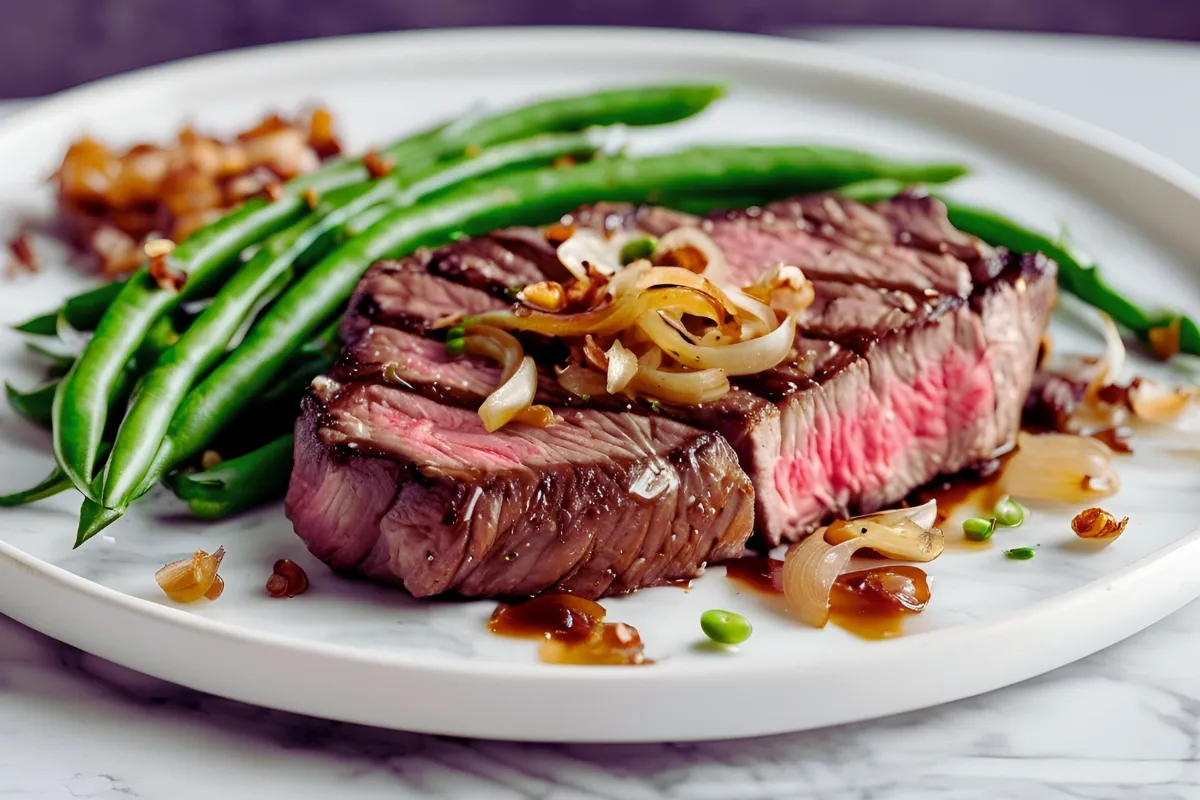Steak and Beans and Onions Recipe
Why This Recipe is a Classic Combination
There’s something magical about the combination of steak, beans, and onions. This trio brings together robust flavors, wholesome nutrition, and a comforting sense of familiarity. The steak, with its juicy tenderness, pairs beautifully with the earthy richness of beans and the sweet, savory notes of onions. Together, they create a balanced dish that satisfies even the heartiest appetite.
For centuries, dishes featuring this combination have been beloved in homes and restaurants alike. Whether grilled to perfection, slow-cooked, or seared in a sizzling pan, this meal never fails to hit the spot. In addition, it’s not just about the flavor—it’s also about the versatility. You can whip it up for a fancy dinner party or a simple weekday meal. Furthermore, it’s adaptable to various cooking styles and dietary needs, making it a timeless classic.
Nutritional Benefits of Steak Beans and Onions
If you’re looking for a meal that’s both delicious and packed with nutrients, this is it. Steak provides a rich source of high-quality protein and essential nutrients like iron, zinc, and vitamin B12, which are crucial for energy and overall health. Beans, on the other hand, are plant-based powerhouses. They’re loaded with fiber, which aids digestion, and complex carbohydrates for sustained energy. They’re also a fantastic source of plant protein.
Meanwhile, onions aren’t just there for flavor—they’re packed with antioxidants and compounds that promote heart health. In addition, onions contain prebiotics, which feed the good bacteria in your gut. Combined, these ingredients deliver a meal that’s satisfying, nourishing, and incredibly tasty.
Popularity Across Different Cuisines
It’s not just an American favorite; steak, beans, and onions appear in various forms worldwide. For example, in Latin America, you’ll find dishes like “bistec encebollado” paired with refried beans. Meanwhile, in Mediterranean cuisines, steak is often served with lentils or white beans, seasoned with herbs like rosemary and thyme. In addition, Tex-Mex cuisine takes this combo to new heights with grilled steak fajitas served alongside black beans and caramelized onions.
This global appeal highlights how versatile and beloved this combination truly is. Moreover, it shows how each culture has its unique spin, making it easy to adapt the recipe to your taste.
Who Will Enjoy Steak Beans and Onions Recipe?
Ideal for Protein Enthusiasts and Meal Preppers
Are you a fitness enthusiast looking for a protein-packed meal? Or maybe you’re a busy professional trying to meal prep for the week? Either way, this recipe has you covered. Steak is a go-to for those aiming to build or maintain muscle, thanks to its high protein content. Likewise, beans provide a steady energy source and help you stay full longer. Moreover, onions add a burst of flavor without extra calories, making this a guilt-free indulgence.
Adaptations for Various Dietary Preferences
This dish is incredibly flexible, so you can tweak it to suit almost any diet. For instance:
- Low-Carb Dieters: Skip the beans and double up on steak and onions.
- Vegetarians: Swap out the steak for marinated tofu or tempeh, and use a smoky spice blend to mimic the meaty flavors.
- Gluten-Free Eaters: The recipe is naturally gluten-free—just ensure any added sauces or seasonings are certified gluten-free.
Additionally, you can adjust the seasoning to suit your spice tolerance, making this a dish everyone can enjoy.
Origins of the Steak Beans and Onions Combination
Historical Use of Beans and Onions in Cooking
Beans and onions have been culinary staples for centuries. Historically, beans were a key protein source in many ancient diets, from Native American tribes to Mediterranean cultures. Not only were they accessible and affordable, but they also stored well, making them an essential food for long winters or journeys. Onions, meanwhile, were prized for their versatility and medicinal properties. Ancient Egyptians even revered onions as symbols of eternity!
Together, these ingredients formed the backbone of many traditional recipes, providing sustenance and flavor to communities worldwide.
Evolution of Steak Pairings Over Time
As for steak, it became a symbol of indulgence and prosperity in many cultures. In the United States, the love affair with steak truly took off during the 19th century, as cattle ranching became more widespread. Over time, cooks discovered that pairing steak with beans and onions created a meal that was not only hearty but also perfectly balanced in flavor and texture. Furthermore, this combination grew in popularity thanks to its simple preparation and crowd-pleasing appeal.
Selecting Ingredients for Steak Beans and Onions Recipe
Choosing the Best Cut for Steak in a Steak Beans and Onions Recipe
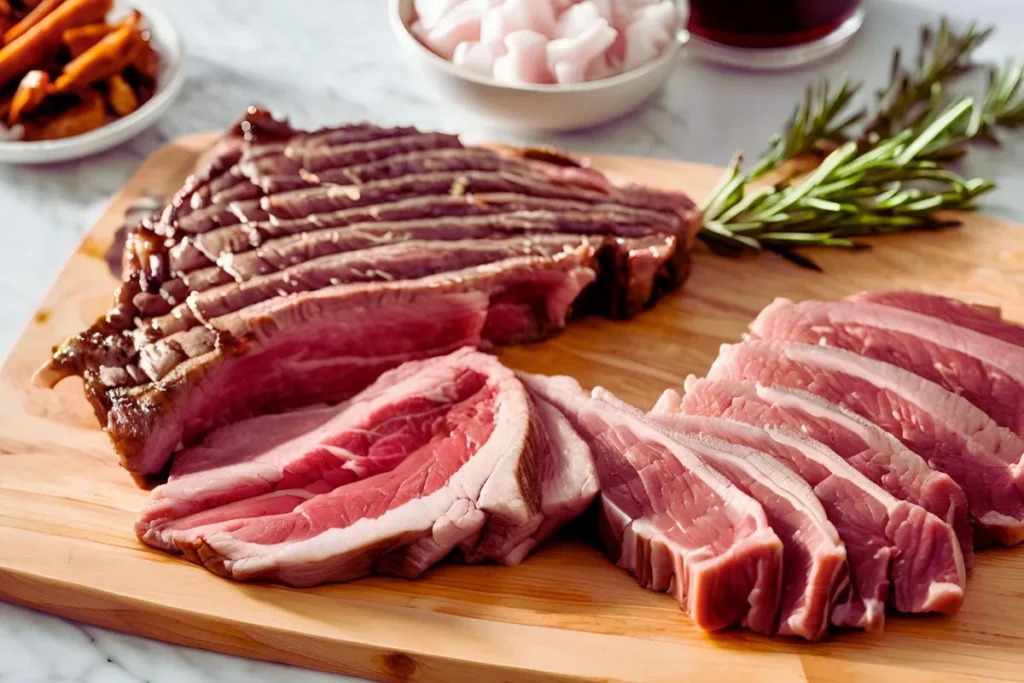
When it comes to steak, the cut you choose can make or break the dish. Different cuts offer unique textures and flavors, so it’s worth knowing which ones work best. For this recipe, you want something tender and flavorful. Ribeye is a classic choice because of its marbling, which melts into the meat as it cooks, adding richness. On the other hand, sirloin is leaner but still packs a punch in terms of flavor.
If you’re aiming for a budget-friendly option, flank steak is a great alternative. While it’s slightly tougher, proper marination can transform it into a juicy delight. Additionally, keep in mind that thickness matters—thinner cuts cook quickly but may be harder to sear properly, while thicker cuts allow for a beautiful crust and a tender interior.
Types of Beans That Work Well in This Recipe
Beans are the backbone of this dish, and choosing the right type can significantly elevate the overall taste. Each variety brings a distinct flavor profile and texture, so it’s all about your preference. For instance, pinto beans have a creamy consistency and mild taste that complements the richness of steak. Black beans, on the other hand, add a slightly firmer texture and a deeper, earthy flavor.
Pinto, Kidney, or Black Beans: Pros and Cons
Here’s a quick breakdown of your options:
- Pinto Beans: Creamy, slightly nutty, and versatile. They soak up seasoning beautifully.
- Kidney Beans: Heartier with a robust texture. Perfect if you prefer a meatier bite in your beans.
- Black Beans: Dense and earthy, these beans add a bold flavor that pairs excellently with smoky or spicy seasonings.
Regardless of the type, always rinse canned beans to reduce sodium or soak dried beans overnight for a fresher taste. Furthermore, combining two types of beans can add a fun twist to the dish.
Types of Onions for Maximum Flavor
Onions are the unsung heroes of this recipe, and the variety you pick can drastically change the flavor profile. Yellow onions are a reliable go-to—they’re mildly sweet and caramelize beautifully, adding depth to the dish. Red onions, on the other hand, bring a sharper, slightly spicy bite that can balance out the richness of the steak. For a touch of indulgence, sweet onions like Vidalia or Walla Walla work wonders.
Sweet, Yellow, or Red Onions: Which to Use and When
- Sweet Onions: Best for caramelizing. Their high sugar content creates a rich, golden hue.
- Yellow Onions: The most versatile option, ideal for both caramelizing and adding to marinades.
- Red Onions: Perfect for a fresh garnish or quick grilling.
Moreover, you can mix onion types to achieve a layered flavor, ensuring every bite is unique and satisfying.
Prepping the Ingredients Steak Beans And Onions Recipes:
Marinating Steak for Tenderness and Flavor
The secret to a tender, flavorful steak often lies in the marinade. A great marinade not only enhances taste but also helps break down the meat’s fibers, making it easier to chew. For this recipe, a combination of olive oil, garlic, soy sauce, and a splash of lime juice works like magic. The acidity from the lime juice tenderizes the meat, while the soy sauce adds a savory depth.
How Onions Help Tenderize Steak Naturally
Interestingly, onions aren’t just for flavor—they can also help tenderize meat. Onions contain enzymes like alliinase that break down proteins, making the steak more tender. Simply blend onions into your marinade or lay slices on top of the steak as it rests. Not only does this infuse the meat with a subtle sweetness, but it also helps achieve that melt-in-your-mouth texture.
Preparing Beans for Enhanced Flavor
Beans might seem straightforward, but with a little prep, they can steal the show. If you’re using canned beans, rinse them thoroughly to remove the briny taste. If you’re starting with dried beans, soaking them overnight is essential to reduce cooking time and improve texture.
Spices and Herbs to Add for a Meat-Like Taste
The key to beans that complement steak lies in the seasoning. Smoky paprika, garlic powder, cumin, and a pinch of cayenne pepper can transform plain beans into a flavorful delight. To mimic the umami taste of meat, try adding a splash of soy sauce or a few drops of liquid smoke. Additionally, fresh herbs like thyme and oregano add a refreshing contrast to the beans’ richness.
Cooking Methods for the Recipe
Grilling vs. Pan-Seared Steak: Which is Better?
There’s an ongoing debate about whether grilling or pan-searing steak produces the best results. Grilling imparts a smoky flavor that’s hard to replicate elsewhere. The open flame chars the exterior, creating a beautiful crust. However, pan-searing gives you more control over the cooking process and allows you to baste the steak with butter, garlic, and herbs for an extra layer of flavor.
Ultimately, the choice depends on your preferences and tools. In addition, consider the weather—grilling might be ideal for sunny days, while pan-searing is perfect for indoor cooking.
Simmering Beans for Depth of Flavor
Beans benefit greatly from a low and slow cooking process. Simmering them with aromatic ingredients like bay leaves, onions, and garlic enhances their flavor. For an extra kick, consider adding a smoked ham hock or a splash of broth. As a result, the beans will develop a rich, savory taste that pairs perfectly with the steak.
Caramelizing Onions for a Sweet and Savory Finish
Caramelizing onions may require a bit of patience, but it’s worth every second. Start by slicing your onions thinly and cooking them over low heat with a touch of butter or oil. Stir them occasionally to prevent burning. As they cook, their natural sugars break down, resulting in a golden-brown hue and a sweet, savory flavor.
To speed up the process, you can add a pinch of sugar or a splash of balsamic vinegar. Furthermore, caramelized onions aren’t just for garnish—they can also be mixed into the beans or layered on top of the steak for an extra burst of flavor.
Perfecting the Steak Beans and Onions
Step-by-Step Cooking Instructions
Preparing the Steak: Marinating, Seasoning, and Cooking
Start with the star of the dish—the steak. Begin by marinating the meat for at least 30 minutes, though overnight is ideal for maximum flavor. Use a marinade made of olive oil, minced garlic, soy sauce, Worcestershire sauce, and fresh lime juice. If you prefer a spicier kick, toss in a pinch of crushed red pepper flakes.
When you’re ready to cook, pat the steak dry to help it sear better. Generously season both sides with salt and freshly ground black pepper. Heat a cast-iron skillet or grill to high heat and cook the steak for 3–4 minutes per side for medium-rare. Remember to let it rest for 5–10 minutes before slicing. This resting period allows the juices to redistribute, ensuring every bite is tender and juicy.
How to Make Flavorful Beans for a Steak Beans and Onions Recipe
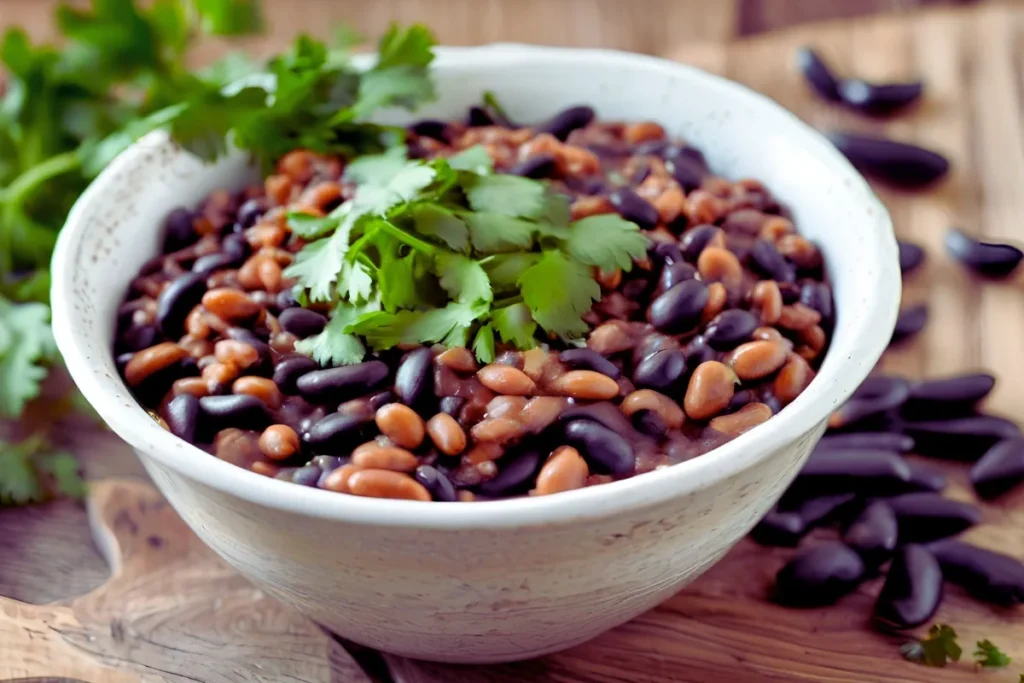
Beans should never be an afterthought—they’re an integral part of this recipe. To start, sauté diced onions and garlic in a bit of olive oil until fragrant. Then, add your choice of beans (pinto, black, or kidney) along with a splash of vegetable broth for added depth.
Season the beans with smoked paprika, cumin, and a dash of cayenne pepper for some heat. Stir in fresh chopped cilantro at the end for a pop of brightness. If you want the beans to be extra creamy, mash a portion of them against the side of the pot and stir everything together. The result is a rich, savory base that perfectly balances the steak.
Sautéing or Grilling Onions for Balance and Depth
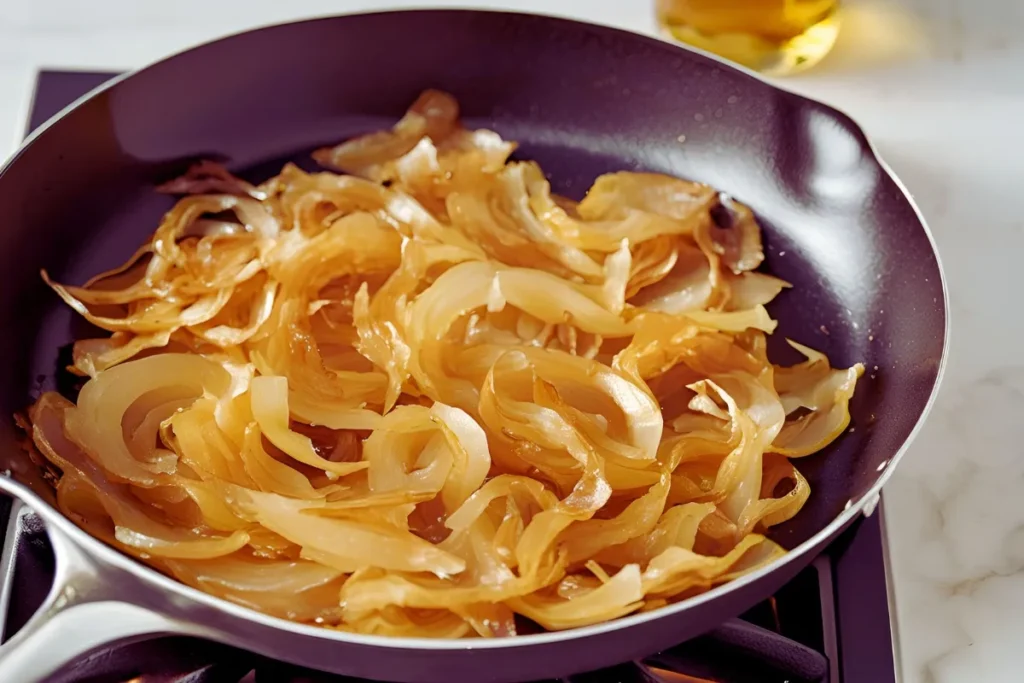
Onions are the glue that ties the whole dish together. For sautéing, slice the onions thinly and cook them over medium heat with butter or olive oil. Add a pinch of salt to help them release their moisture and soften faster. Stir occasionally to prevent sticking, and once they turn golden, they’re ready.
If grilling is more your style, cut the onions into thick rings to prevent them from falling apart. Brush them lightly with oil and grill for about 3–5 minutes per side until they have distinct char marks. Grilled onions add a smoky sweetness that complements both the steak and the beans.
Pairing Ideas for the Meal
Best Side Dishes to Serve with Steak Beans and Onions
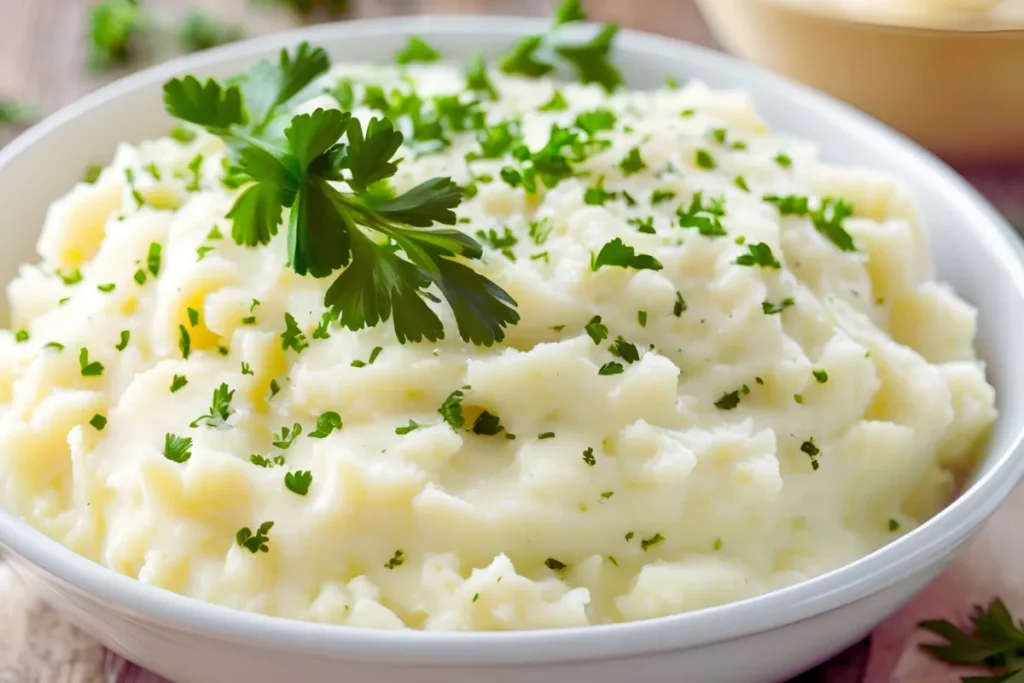
The steak, beans, and onions are fantastic on their own, but adding the right sides can take your meal to the next level. Consider these options:
- Garlic Mashed Potatoes: Creamy and buttery, they pair wonderfully with the savory steak juices.
- Grilled Asparagus: A light and crisp vegetable side that balances the richness of the dish.
- Cornbread: Sweet and crumbly, it’s perfect for soaking up any leftover sauce from the beans.
Additionally, a simple green salad with a tangy vinaigrette can refresh your palate between bites.
Beverage Pairings for a Complete Dining Experience
Choosing the right drink can enhance your dining experience even further. For steak, a bold red wine like Cabernet Sauvignon or Malbec works beautifully. If you prefer beer, opt for a robust stout or a smoky porter.
Non-alcoholic options can be just as exciting—try sparkling water with a twist of lime or a homemade iced tea infused with fresh herbs. For something a bit more indulgent, a creamy horchata or a spiced chai latte can round out the meal perfectly.
Variations on the Recipe
Adding Vegetables for a Healthier Option
If you’re looking to make this dish even more nutrient-packed, adding vegetables is a great idea. Bell peppers, zucchini, or cherry tomatoes can be sautéed or grilled alongside the steak and onions. These vegetables not only add color but also provide additional vitamins and minerals.
Roasted sweet potatoes are another excellent addition, offering a hint of natural sweetness that complements the savory flavors. Moreover, you can mix greens like spinach or kale into the beans for added texture and nutrition.
Using Different Proteins for Unique Flavors
While steak is the classic choice, this recipe can easily be adapted to feature other proteins. For example, pork chops or tenderloin offer a slightly sweeter taste that pairs well with caramelized onions. Alternatively, chicken thighs or drumsticks marinated in the same steak marinade can deliver a juicy, flavorful meal.
For a pescatarian twist, grilled salmon or seared tuna steaks work surprisingly well with beans and onions. Even plant-based options like portobello mushrooms or marinated tofu can be used to create a satisfying dish.
Conclusion and Final Tips for Success
Common Mistakes to Avoid When Cooking This Recipe
To ensure your steak, beans, and onions come out perfectly every time, avoid these common pitfalls:
- Skipping the Resting Period for Steak: Cutting into the steak too soon can cause the juices to spill out, leaving the meat dry.
- Overcooking the Beans: Simmering beans for too long can make them mushy and lose their texture.
- Burning the Onions: Patience is key when caramelizing onions. High heat will cause them to burn rather than brown.
By keeping these tips in mind, you’ll have a dish that’s both delicious and visually appealing.
Tips for Storing Leftovers and Reheating
If you have leftovers (lucky you!), store each component separately for the best results. Place the steak in an airtight container, beans in another, and onions in a third. Refrigerate them for up to three days.
When reheating, use low heat to maintain the flavors and textures. For steak, a quick sear in a hot skillet can bring it back to life. For beans, reheat them in a saucepan with a splash of broth to prevent them from drying out. As for onions, a gentle warm-up in a pan over low heat will do the trick.
FAQs
What Can I Add to Beans to Add Flavor?
Beans are like a blank canvas, ready to soak up whatever flavors you throw at them. To enhance their taste, start with aromatic vegetables like onions, garlic, and bell peppers. Sauté them in olive oil before adding the beans to build a flavorful base.
Tips for Enhancing Flavor with Spices and Herbs
Seasoning is key to making beans stand out. Smoky spices like paprika and cumin are fantastic for adding depth. Don’t forget dried herbs like oregano, thyme, or even a bay leaf during cooking. Additionally, a pinch of cayenne pepper or chili powder can give the beans a subtle kick.
Using Meats, Broths, or Vegetables to Boost Taste
For a richer flavor, simmer beans with a smoked ham hock or crumbled bacon. If you’re vegetarian, swap the meat for vegetable broth infused with a splash of liquid smoke. Roasted vegetables, like tomatoes or squash, can also add complexity and sweetness to the dish.
How Do Onions Tenderize Steak?
Onions have a secret weapon when it comes to tenderizing steak: natural enzymes. These enzymes break down proteins in the meat, making it softer and juicier. Additionally, onions impart a subtle sweetness that balances the savory flavors of the steak.
The Science Behind Onion Enzymes and Meat Tenderization
The enzyme in onions, alliinase, reacts with the meat’s proteins to loosen their structure. This reaction works best when the onions are raw and finely grated or blended into a marinade. As a result, the meat becomes tender without losing its integrity.
Best Practices for Using Onions in Marinades
To maximize the tenderizing effect, combine finely chopped or blended onions with an acid like lemon juice or vinegar. Let the steak marinate for at least 30 minutes, though longer is better. Moreover, avoid adding salt to the marinade too early—it can draw out moisture and dry out the meat.
What Kind of Meat Goes With Beans?
Beans pair beautifully with a variety of meats, making them an incredibly versatile ingredient. While steak is a classic choice, other cuts of beef and even non-beef options can work just as well.
Other Cuts of Beef That Pair Well with Beans
If you’re looking to switch things up, try skirt steak or brisket. Skirt steak is thin and cooks quickly, while brisket is slow-cooked to tender perfection. Additionally, ground beef can be sautéed with spices and mixed into beans for a hearty, one-pot meal.
Exploring Non-Beef Options Like Pork or Chicken
Pork chops, pulled pork, or even grilled chicken thighs pair wonderfully with beans. These meats bring a slightly sweeter flavor that complements the beans’ earthiness. For a unique twist, smoked turkey legs or sausages can add depth and smokiness to the dish.
How to Season Beans to Taste Like Meat?
Seasoning beans to mimic meat flavors involves layering spices and aromatics. Start with a base of onions and garlic, then build on it with smoky, savory ingredients.
Key Ingredients to Mimic Meat Flavors in Beans
Liquid smoke, soy sauce, and smoked paprika are your best friends here. They create that meaty umami flavor that beans often lack. Additionally, nutritional yeast can add a cheesy, savory note, while a splash of Worcestershire sauce provides depth.
Balancing Smoke, Sweetness, and Savory Notes in Beans
Achieving the perfect flavor profile is all about balance. For smokiness, use ingredients like chipotle peppers or smoked salt. Add a hint of sweetness with a drizzle of maple syrup or honey, and don’t forget a savory element like bouillon or tomato paste. Together, these flavors create beans that are rich, complex, and utterly satisfying.

